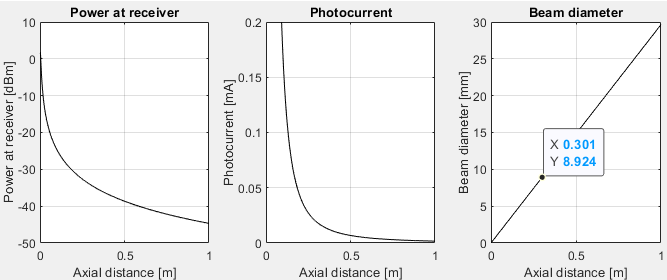The sine of 1 degree is .017. .017 x 300 mm is 5.2 mm.
If you look at the data sheet (and are willing to trust the data sheet), it's clear that the beam spread is half a degree or less. Then your spot size will be on the order of 2 mm.
Furthermore, the data sheet for the S1880 states that the photosensitive area is 12 mm x 12 mm. So a 2-3 mm dia beam seems an excellent fit, and you don't need to add any optics to the detector. The PSR resolution is about 150 to 250 um for a 200 um spot size, and increasing the spot size will not change the resolution proportionally, as long as the spot is a symmetrical circle.
What you do need to do is to attenuate your beam. The laser diode you've shown has a nominal power output of 100 mW. The nominal sensitivity of the PSD is 0.6 A/W at 900 nm, with a saturation current of 0.5 mA. Since 0.6 A/W times 100 mW is 60 mA, you'll be overdriving the PSD by a factor of 100, and it's anybody's guess how it will respond.
If you insist that you need a smaller spot size, this is "easily" done by putting a small lens in front of the LD. However, since the laser emitter is (from the data sheet) 200 x 200 um, the same as your desired spot size on the PSR, you want a magnification of 1 or better. For a simple lens, this implies that the lens must be halfway between the LD and the PSR, which means a lens assembly which is 150 mm long. Furthermore, since you are trying to focus the LD spot, rather than collimate, the LD spot will only be in focus at a particular distance, and you will have little leeway in terms of detector distance.
You might be better off trying to collimate the LD using a fairly short focal length lens with a separation equal to the focal length, and then masking the output to a 200 um spot with a precision pinhole - but then you'll have to deal with diffraction issues.
At your level of experience, you must resign yourself to a good deal of messing about and (failed) experimentation. Do not think that you can do a theoretical design and have it work - you just don't know enough. Yet. The process will educate you considerably, though.
Just remember: "Good judgement comes from experience. Experience comes from bad judgement."

